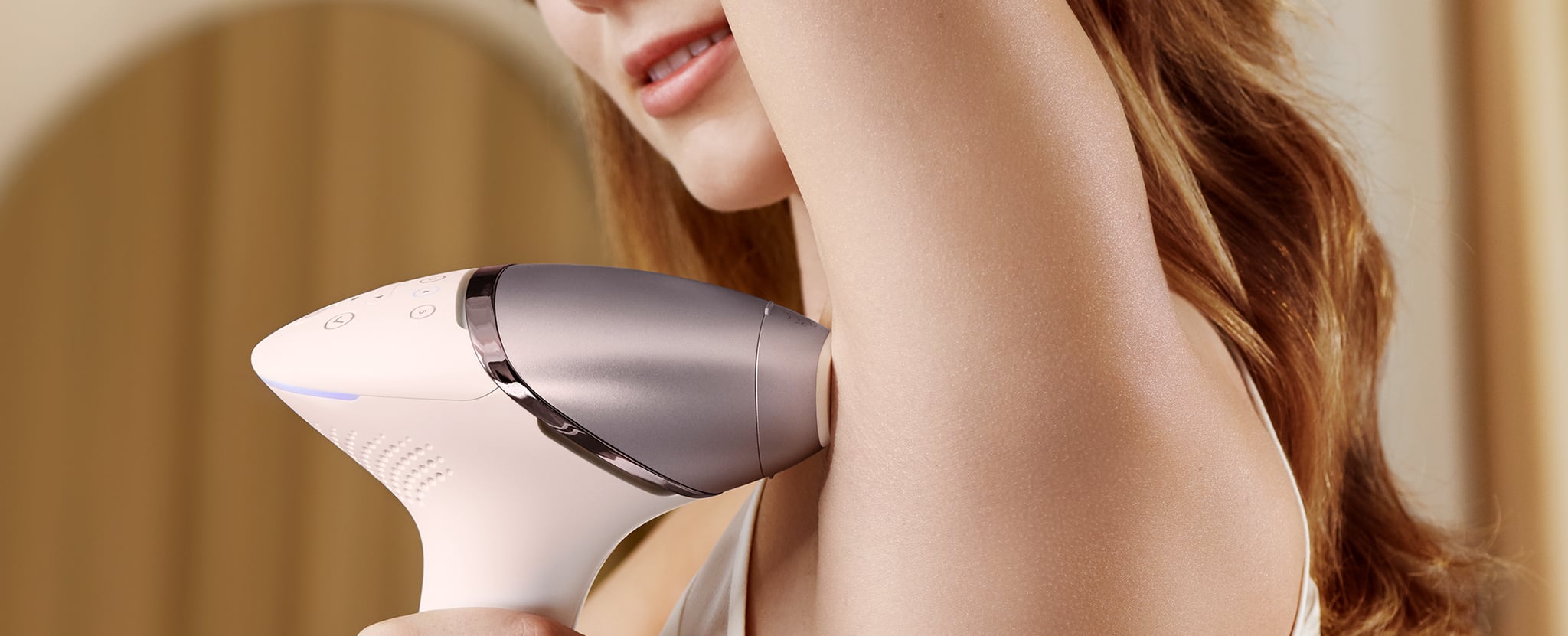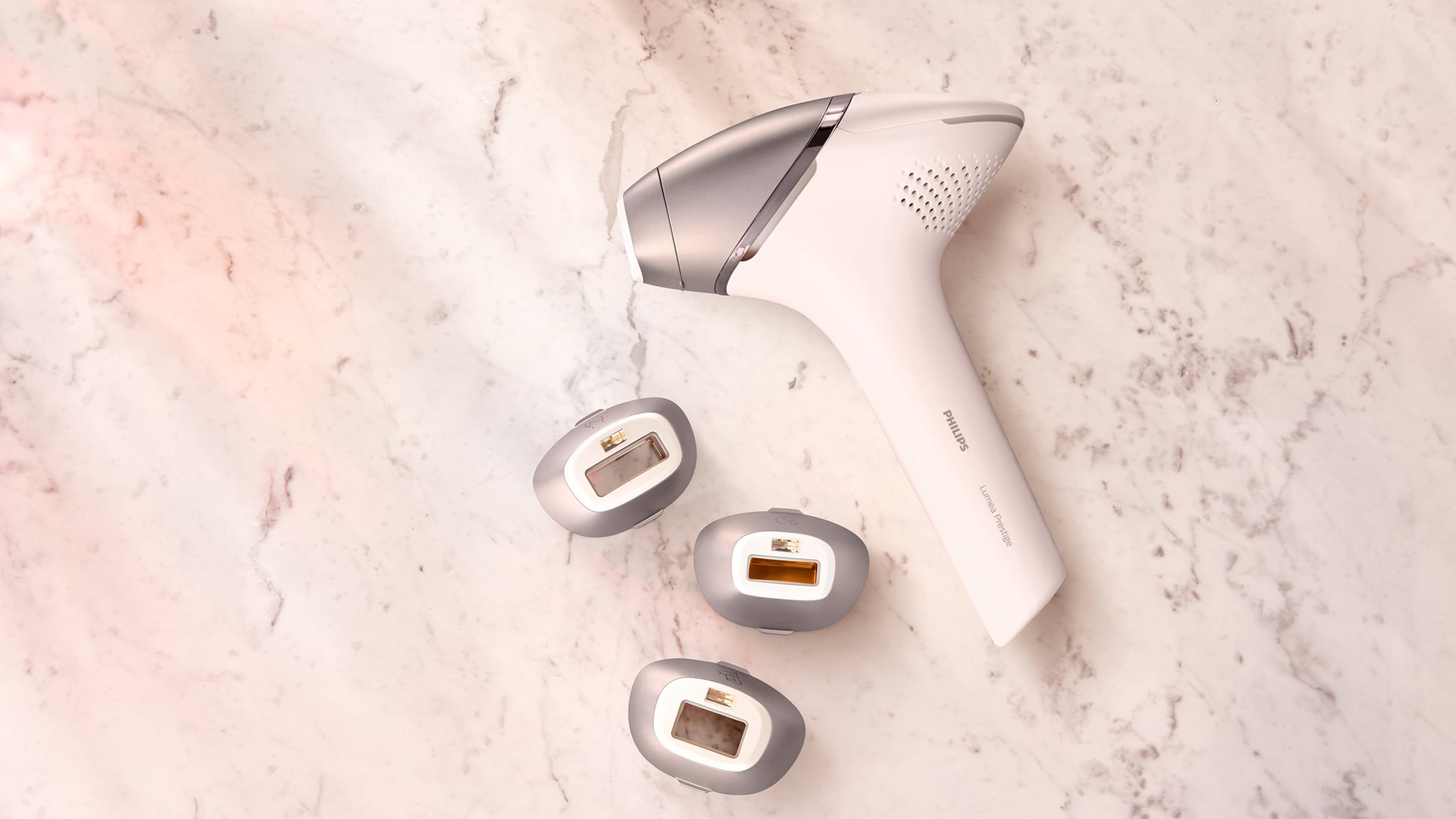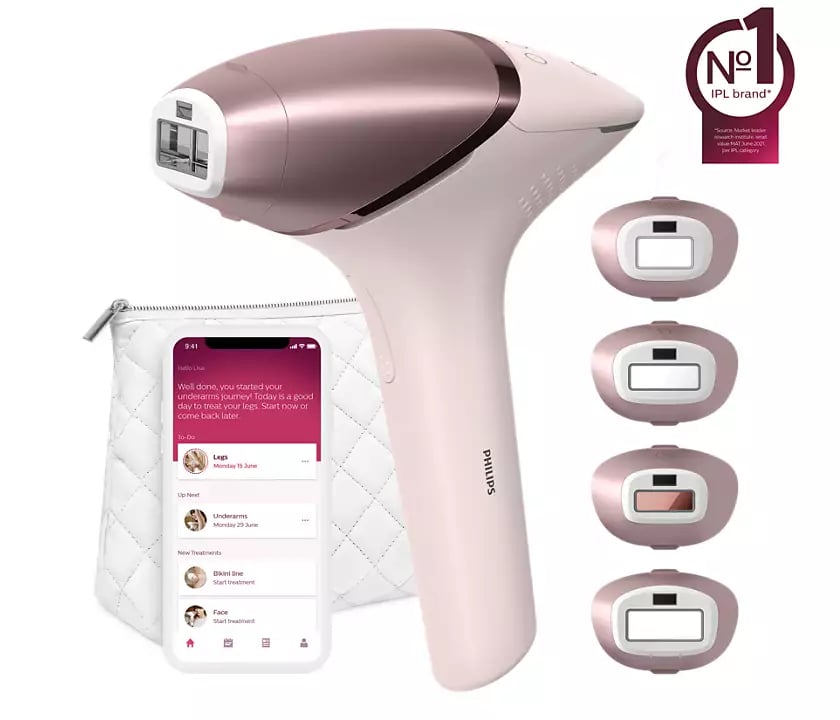
Everything You Need to Know About At-Home IPL Hair Removal
Is It Time to Try IPL? We're Convinced It's the Secret to Smooth Skin

Like a lot of beauty practices, hair removal goes back centuries. Luckily, we no longer have to use sharpened clam shells or shark's teeth to get a silky-smooth, hair-free finish. Today, we have IPL devices.
Not only have modern techniques usurped their shellfish predecessors, but thanks to an ever-evolving industry, hair removal has also become less painful and more convenient. About 20 years ago, we saw perhaps the most significant innovation yet with the introduction of IPL, a gentle, nick-free, ingrown-hair-curbing, inflammation-avoidant method. Sounds too good to be true? Allow us to make you a believer.
What Is IPL?
IPL, also known as Intense Pulsed Light, uses gentle pulses of light to target the pigment in your hair and essentially freeze your follicle from growing more hair. After the first use, you can expect your hair to fall out gradually; this process can take anywhere from several days to a few weeks. Eventually, your body will begin to grow less hair in those designated areas.
Speaking of designated areas, IPL devices can be used all over the body — even the face. To be clear, IPL technology does not emit the same ultraviolet light as the sun, so UVA/UVB damage isn't a factor. In fact, the same technology has been popularised in the skin-care community to help combat wrinkles and sun damage.
IPL, like many other hair-removal treatments, can be done with a professional, but it's also one of the safer, more convenient options to try at home. It's no secret that some professional treatments are unpleasant to endure, but some of the latest IPL innovations work so efficiently that you shouldn't break a sweat. While everyone's pain threshold is different, IPL pain is considered mild — think the pluck of a stubborn hair or the snap of an elastic band. Its temporary, quick, and not all that memorable.
What’s the Difference Between IPL and Laser Hair Removal?
Think of IPL and laser as fraternal twins. They're very similar, but they have significant differences, too. While laser emits single wavelengths of light, IPL delivers multiple wavelengths. They both utilise light and heat to freeze and disrupt hair growth, resulting in similar results in varying degrees. The endgame for both: long-term hair removal and reduced hair growth.
How Do You Prep For IPL?
The best part about IPL treatments is that you don't have to wait for your hair to grow a certain length. For hair-removal newcomers, this is kind of a big deal: other popular methods, such as waxing or epilating, often recommend letting your hair grow out nearly a centimetre. That's not necessary with IPL, which means there's no awkward hair-regrowth period when you're forced to live with unwanted stubble.
Furthermore, it's actually recommended you use an IPL device on hairless skin. The technology is built to target the pigment at the root of the hair, so stubble might disrupt or weaken this process. The best way to get the job done is to shave as the root of the hair follicle will still be intact below the surface. If you prefer to wax or epilate, we recommend waiting 24 to 48 hours before using your IPL.
One more tip — skin should be exfoliated before using IPL and moisturised after; we recommend an oil-free formula to avoid clogging pores.
How Many IPL Treatments Does It Take to See Results?
IPL technology works quickly, but you won't see long-term results until after a few sessions. After your first time, your hair will most likely begin to shrivel and shed. While your hair will continue to grow, it'll do so at a slower rate. If there is new growth between treatments, the hair will most likely be thinner and less noticeable. It's also important to keep in mind that some targeted areas might grow hair at different rates — for example, after a few sessions, your underarms might have a different level of regrowth than your legs. It depends entirely on your body and the growth phase of your follicles.
Quick biology lesson: hair grows in a cycle of three phases, and IPL technology only targets active follicles in the first phase of that cycle (i.e., the anagen phase when you're growing new hair from the root). That's why maintaining an IPL treatment schedule is important for long-term results. The more you use the device, the more chances it has to target and freeze active follicles.

How Often Should You Do IPL Treatments?
This can depend on the kind of device you're using; each brand's unique technology differs. Typically, your treatments will be more frequent in the first year. After that, as your hair regrowth periods slow, you should only need occasional touch ups.
For example, if you opt for a product like Philips Lumea Series 9000, you should use your IPL device once every two weeks for the first four treatments. These biweekly treatments should fall at least three days before or three days after that two-week checkpoint. After the first four treatments are complete, treat your skin every four weeks (that’s about eight months of sessions). Depending on your hair regrowth, plan to continue with yearly touch-ups.
Who Is Suitable To Use an IPL Device?
Although technology can vary, most IPL devices aren't suitable for everyone. Since IPL technology targets the pigment in hair, people with naturally light hair — blond, red, and grey — should sit this treatment out. Most experts also recommend alternative hair-removal options for people with deep skin tones. This light-based technology is attracted to melanin specifically, so someone with darker skin might experience ineffective results or skin damage, discolouration, and potential scarring.
If you have any underlying medical conditions, it's best to check with your doctor before trying light-based hair removal treatments at home. IPL can be effective in treating some of the potentially unwanted side effects of PCOS, but, again, check with a professional beforehand. IPL isn't recommended for use while pregnant or breastfeeding.
What’s the Best At-Home IPL Device?
There are lots of at-home devices to choose from, but when it comes to convenience, ease, and affordability, we prefer Philips Lumea Series 9000. This cordless device offers unique capabilities that others do not, such as curved attachments for different areas of your body. There are four attachments total — for the body, face, bikini, and underarms, respectively — so there's an option for you no matter your body-hair preference.
Philips Lumea Series 9000 also utilises an integrated SmartSkin Sensor to select the right light setting for your skin tone. For example, if you happen to get a little sunkissed after a day at the beach, the sensor will detect this change and adjust the light setting accordingly. This at-home device also offers uniquely effective results. Most people see 92 percent hair reduction in just three treatments. If you follow your treatment schedule, you'll see hair-free results in about six months.
Maintaining a strict hair-removal schedule can be expensive. Considering the fact that in-office treatments can cost upwards of £400 per session, buying an at-home device that costs about the same amount could help your bank account in the long term. (For the record, Philips Lumea Series 9000 is under £500.) Still unsure if IPL is right for you? Philips offers a try-and-buy programme that allows you to pay monthly installments of £38.50 for the device — if you realise it's not a fit, then you're able to cancel and return it.
